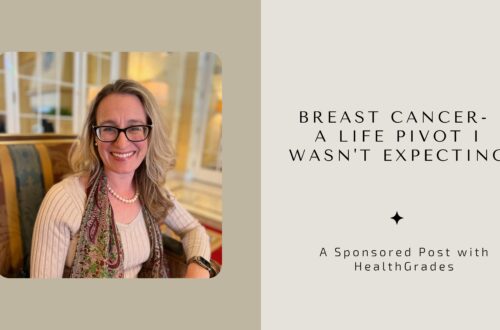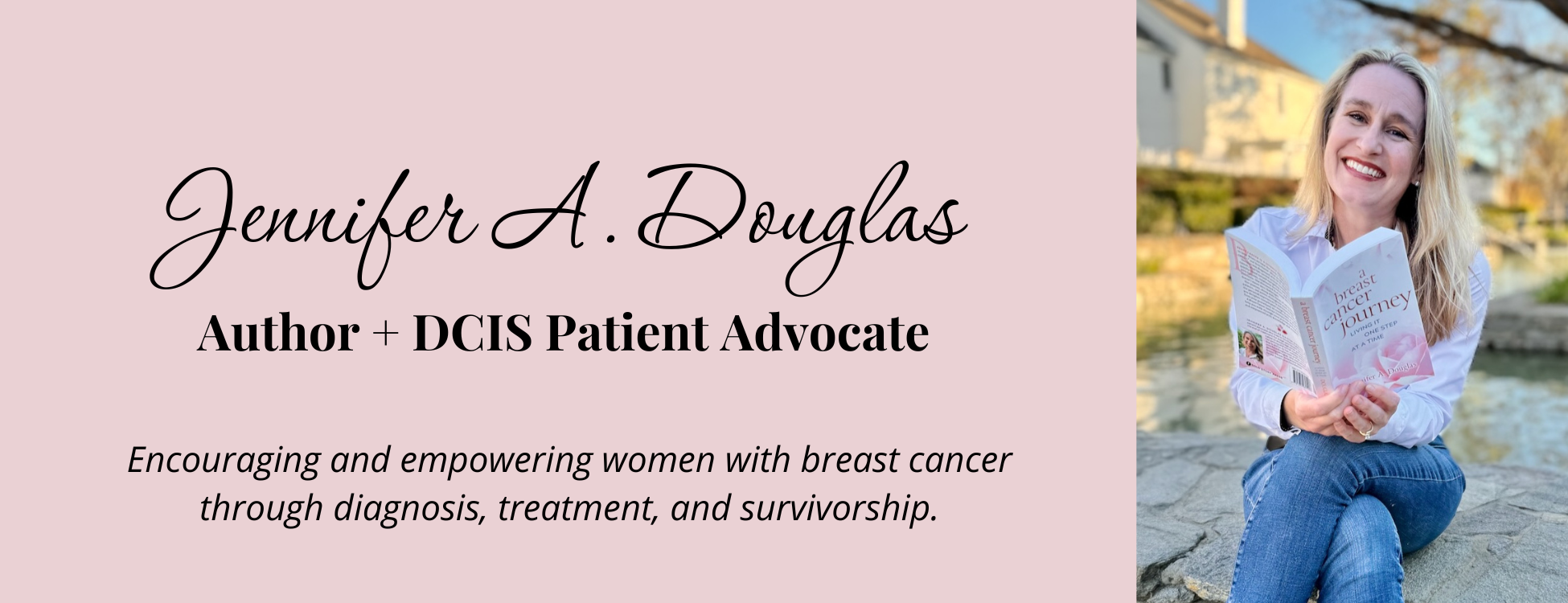
Surgery Choices: Why I Decided to Have a Lumpectomy
I chose to have a lumpectomy in fall 2019 after my DCIS diagnosis. This decision-making process was a challenging one, and I wanted to share with you how I walked through it. There were five major reasons that I decided to choose a lumpectomy instead of a mastectomy.
Note: I am not a doctor. I am not giving medical advice in this post. I would like only to share my patient experience with you so that you can understand how I came to my decision. Always consult your medical team for advice. See this page for more information.
Once I was diagnosed with DCIS, it seemed like I had so many choices to make. The most major decision was which surgery to have. Would I have a lumpectomy to remove the DCIS, or would I choose a mastectomy?
There were five major reasons that I chose a lumpectomy over a mastectomy for this particular diagnosis.
1. DCIS in One Location
My DCIS was located in one area of my right breast. It was found during my very first biopsy, and it was about 4 mm in size.
I had many mammograms, ultrasounds, and an MRI, and the imaging didn’t reveal any other areas of DCIS in either of my breasts.
The DCIS was low grade, small, and only in one location in my breast. This meant that my surgeon would be able to remove the cancer while preserving a nice cosmetic appearance in my breast. This was important to me, and something that I had many conversations with him about.
If my DCIS was in multiple locations in my breast, I would have made a different surgical choice.
2. No Genetic Factors
I was 41 at the time that my DCIS was discovered. Because of my relatively young age at diagnosis, my surgeon wanted me to consider genetic testing. This would help us better understand if I had a genetic mutation such as BRCA that would increase my risk of future cancers.
Between 5- 10% of cases of breast cancer are associated with a genetic mutation, so genetic testing isn’t standard in the United States when someone is diagnosed with breast cancer.
I met with a genetic counselor, who had me fill out a family history of cancers and then was able to talk about the genetic testing options available to me. I was offered three levels of testing through my doctor’s office. Your options may vary depending on where your genetic tests will be performed. Here are the three options I was offered:
- Breast cancer risk test: Tested for the most common genetic mutations associated with Breast cancer.
- Expanded BRCA Test: Ran a profile of additional genes associated with breast cancer risk
- Full CancerNext : Included additional genes would impact overall cancer risk
We ordered a rush on the testing for the breast cancer risk so that we could make sure to get the results before my surgery.
I decided to run all three genetic tests at this time because I wanted to have as much information as possible in hand to help me understand my full genetic risk factors for cancer.
If I ended up being positive for the genetic mutations associated with increased breast cancer risk, I would plan on doing a mastectomy.
It was a great joy when my genetic counselor called me to tell me that I was negative for all of the genetic mutations associated with cancer risk.
I felt even more comfortable choosing a lumpectomy because I didn’t have any genetic risk factors which would increase my risk of invasive cancer.
3. No Lymph Node Involvement
One of the ways that breast cancer can spread outside of the breast is through the lymph nodes. If cancer has spread to the lymph nodes, then surgeons will remove the impacted lymph nodes as a part of the surgical treatment.
Initially, my surgeon was confident that there was no lymph node involvement in my case. My initial imaging only indicated a small area of DCIS on my right breast.
Then I had an MRI which led to three more areas of concern, all on my left side.
One of the areas of concern was a lymph node on my left side. This was the opposite breast of the DCIS diagnosis. The MRI and subsequent ultrasounds were inconclusive with regards to this lymph node. So, my surgeon ordered a biopsy of this lymph node to see if it was cancerous.
There are several lymph nodes in the breast, and not all of them can be tested at this time using a core needle biopsy.
Sometimes the lymph nodes need to be tested during surgery using a different procedure.
In my case, there was a lymph node under my armpit, called an axillary lymph node which could be tested for malignancy using an ultrasound-guided core needle technique. Here is a rather technical article if you’d like to read about it.
My lymph node biopsy came back negative!
I was thrilled with this result because it was the final piece of medical information that I needed to make my surgical decision with confidence.
4. Quicker Recovery Time
As I discussed my treatment options with my surgeon, I asked him which surgery he would recommend. He told me that his treatment preference for me was a lumpectomy because of the small area of DCIS and the quick recovery.
The surgical recovery from a lumpectomy, at least in my case was about two weeks. After that time, I was cleared to do most of my normal activities.
If I had decided on a mastectomy plus reconstruction I would be looking at a much longer recovery time, one that would be months instead of weeks.
5. Keep the Girls (for now)
The final, and probably the most important reason, that I chose to do a lumpectomy was that it would allow me to keep my breasts.
I wasn’t ready to say goodbye to my breasts yet. My diagnosis gave me the option to keep them. So, I did!
I had some frank conversations with my surgeon about his confidence to get clean margins and also to preserve the cosmetic appearance as much as possible. We discussed his techniques at length, and I was confident that his goal was to remove the cancer with as little impact to my remaining breast tissue.
I’m about a year out of surgery, as of this writing. I have two small scars: one from the removal of a benign lump, and one from the cancer. I am really satisfied with the cosmetic appearance after the surgery.
We all have unique diagnosis and treatment options. Making a surgical decision is one of the biggest decisions we make in our breast cancer treatment. We must take the information we have and then move forward with a choice. Once we have done that, we can begin our journey towards recovery!
Do you have any words of encouragement for other people facing a surgical decision in their breast cancer journey?
Jennifer Douglas
Jennifer Douglas is an author, patient advocate, and DCIS breast cancer survivor. After navigating her own breast cancer journey in 2019, she began writing and encouraging others who were newly diagnosed. Her resources include her book, "A Breast Cancer Journey: Living It One Step at a Time," and her online support course, "Encourage: Breast Cancer and Beyond." Jennifer also actively supports patients through her online presence and direct involvement in communities and support groups, offering guidance and encouragement every step of the way.


You May Also Like

HealthGrades Post: Breast Cancer- A Life Pivot I Wasn’t Expecting
August 8, 2022
Breast Cancer & Natural Disasters: Resource Guide
January 9, 2025

3 Comments
Jennifer
I had a DCIS diagnosis at the start of lockdown this year in March (I’m in New Zealand) Mine was 60mm of suspicious calcifications seen on routine mammogram. My surgeon never offered me the option of mastectomy, only ever lumpectomy. Maybe because I have big boobs (cup size F). In the end I got super wide margins because the actual DCIS was only 6mm but the remaining calcifications were benign. I would likely have actually chosen double mastectomy as I’m sick of big boobs and extremely fearful about cancer and recurrence. Glad you are happy with your decision.
I have a question for you – how do you get past the fear of recurrence? My next mammogram is in March next year and I’ve already started to fret! Sending love from NZ xxx
Jennifer Douglas
Fear of recurrence is something that I acknowledge. I just had my one year scans, and I was anxious going into them. Here is how I managed the anxiety as I felt it. I trust my medical team that they are choosing the right frequency of scans for me. If there is something, they are monitoring me closely and we’ll deal with that problem if it happens. Somehow, thinking that way helps me acknowledge the reality of my fears, and then move on to the next step in the process. I just found out my one year scans were benign and I don’t need to go back again for 6 months. That’s 6 months I don’t need to worry about being diagnosed with breast cancer! That makes me smile! Thank you for reaching out! Happy Holidays!!
Jody
I had bilateral breast cancer and had bilateral lumpectomies. My decision was similar to yours based on size of tumors, no node involvement, ER/PR+, Her2-. I could always take more off, but I couldn’t put it back. All the facts aligned to start conservative. Radiation, however, was difficult.